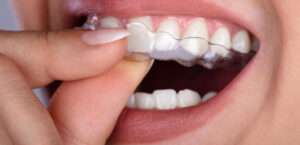Posted on March 16, 2024

Clear aligners have become a popular choice for those looking to straighten their teeth without the bulk and visibility of traditional braces. What makes them stand out is their wearability.
Imagine wearing glasses that not only improve your vision but also make you feel like they’re barely there. That’s the kind of comfort clear aligners offer. They’re designed to fit snugly over your teeth, moving them gently and gradually into place.
Since they’re made of smooth, clear plastic, there are no sharp edges or metal brackets to worry about, which means less irritation for your mouth. Plus, you can take them out before eating or brushing, making them a convenient option for maintaining your dental hygiene and enjoying your favorite foods without restrictions.
When it comes to choosing clear aligners, it’s important to go with a trusted provider that offers both effectiveness and a comfortable experience. This is where Smilebliss comes in. Smilebliss not only ensures that your aligners are custom-made for the perfect fit but also provides ongoing support throughout your journey to a better smile.
Ready to start your journey towards a confident, hassle-free smile? Contact us today to learn more!
Clear aligners offer a discreet way to correct dental alignment. Comfort is a primary advantage due to their construction from smooth materials tailored for individual users.
The materials used to manufacture clear aligners are typically a proprietary blend of medical-grade, high-quality thermoplastic polymers. This material choice is strategic; it ensures that the aligners are both durable and smooth to the touch, reducing the risk of irritation to the soft tissues of the mouth.
In comparison to traditional braces, which may have metal components that can cause discomfort or even small injuries, clear aligners boast a uniform texture that is less likely to irritate the gums, cheeks, or tongue.
A well-fitting clear aligner is key to comfort and effectiveness. Each aligner is custom-made using precise digital scans of the patient’s teeth.
This customization ensures that aligners fit snugly over each tooth without significant gaps or misalignment, which could otherwise cause sore spots or undue pressure on any particular tooth. Constant gentle pressure is maintained ideally, which is essential for the gradual movement of teeth into their desired positions.
Moreover, the custom fit means that aligners should be secure enough not to dislodge during speech or normal daily activities but still be designed to be removable for eating and oral hygiene practices.
Incorporating clear aligners into one’s day-to-day activities hinges on understanding their impact on eating, speaking, and oral hygiene.
 With clear aligners, individuals must remove them before consuming anything aside from water. This ensures that the aligners do not trap food particles or suffer damage from hot beverages. Eating requires planning, as aligners should be worn for roughly 20-22 hours daily.
With clear aligners, individuals must remove them before consuming anything aside from water. This ensures that the aligners do not trap food particles or suffer damage from hot beverages. Eating requires planning, as aligners should be worn for roughly 20-22 hours daily.
New aligner wearers often experience a brief adjustment period where their speech may slightly alter. However, this is typically short-lived, and clear aligners are generally appreciated for their discreet appearance, fostering confidence in social settings.
Effective oral hygiene practices are essential when using clear aligners. Users should clean their aligners daily with appropriate methods and maintain regular teeth brushing and flossing to prevent bacterial buildup that could lead to dental issues.
During the initial phase of wearing clear aligners, an individual may experience discomfort as their teeth begin to shift. However, this sensation tends to decrease as one adapts to the aligners over time.
When a person first starts wearing clear aligners, they may feel a sense of tightness or mild discomfort as the aligners apply pressure to the teeth. This is a normal part of the adjustment period and is indicative of the aligners working to move teeth into their proper position.
As the days progress, individuals typically become more accustomed to their clear aligners. The initial discomfort fades, often within a few days, as the mouth adjusts to the new aligners. Consistent wear is crucial during this period to ensure not only comfort but also the effectiveness of the treatment.
When comparing the comfort of clear aligners and traditional braces, patients’ experiences vary based on individual sensitivity and the complexity of dental corrections required.
Clear Aligners:
Traditional Braces:
| Feature | Clear Aligners | Traditional Braces |
|---|---|---|
| Edges | Smooth | Sharp, may need wax |
| Removability | Yes | No |
| Adjustment to Wear | Shorter period | Longer, may need wax |
| Soreness from Use | Mild to moderate | Moderate to intense |
| Hardware Breakage | Not applicable | Possible, causing sores |
In terms of hygiene, aligners can be removed, simplifying brushing and flossing, whereas braces may complicate oral hygiene practices, potentially leading to discomfort from trapped food particles.
Both treatments may cause temporary discomfort but serve the purpose of dental correction effectively. The choice between the two often depends on the severity of the alignment issues, personal comfort, and lifestyle preferences.
Clear aligners, though known for their comfort and aesthetics, require diligent long-term care and adherence to wear schedules. They should be worn for 20 to 22 hours daily to ensure effective treatment. Patients are responsible for removing them only for meals and oral hygiene routines.
Maintenance routines include:
The patient’s commitment to maintenance ensures both oral health and aligner integrity. Effective upkeep helps preserve the aligner’s clarity and prevents the build-up of harmful bacteria.
Tips for aligner care:
Long-term wear involves following the provided wear schedule strictly and progressing through the aligner series as directed. Each aligner is typically worn for about two weeks before moving on to the next set in the series. Not adhering to the prescribed schedule can negatively impact treatment progress.
Periodic dental visits are essential to monitor the treatment’s progress and make any necessary adjustments to the care plan. During these visits, the dental professional can also inspect the aligners for any issues that may require attention.
Through consistent wear, routine maintenance, and regular dental check-ups, patients can help achieve the best possible outcome from their clear aligner treatment.
Unlock the secret to a flawless smile without the hassle of traditional braces. Smilebliss clear aligners offer a seamless, comfortable, and virtually invisible solution to straightening your teeth.
With our state-of-the-art technology and personalized treatment plans, achieving your dream smile is easier than ever. Don’t wait to transform your smile and boost your confidence.
Reach out to Smilebliss today and take the first step towards the perfect smile you deserve.
Individuals may experience tenderness or sensitivity with new aligners, as well as potential sores or irritation of the mouth. Aligners may initially affect speech but generally become more comfortable with use.
Clear aligners typically offer a smoother experience against the cheeks and gums compared to traditional braces. The lack of brackets and wires reduces the chances of mouth irritation that metal braces might cause.
The first few days after beginning treatment or switching to a new aligner might lead to some tenderness or discomfort as teeth start to shift. This sensation usually diminishes as the mouth adjusts to the aligners.
To manage any discomfort, users can use orthodontic wax on particularly tender areas, rinse their mouth with warm saltwater, or take over-the-counter pain relievers as directed by an orthodontist.
Older adults may have more sensitive gums and teeth, which could increase discomfort with orthodontic treatments, including clear aligners. An orthodontist can advise on adjustment period expectations based on individual dental health.
Comfort levels may fluctuate during treatment. Initial discomfort is common and may reoccur with each new aligner set. Over time, most users find the aligners more comfortable as their teeth gradually align to the desired positions.